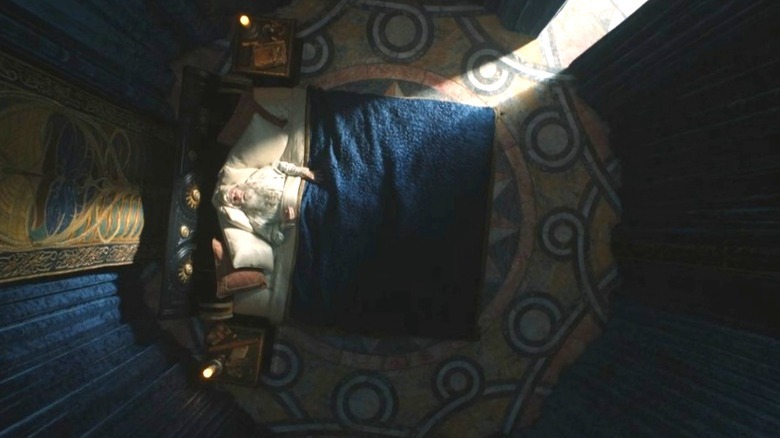Who Is King Tar-Palantir On The Rings Of Power?
Contains spoilers for "The Lord of the Rings: The Rings of Power" Season 1, Episode 5
When Galadriel and Halbrand arrive on the shores of Númenor in "The Lord of the Rings: The Rings of Power," they're greeted by an opulent nation at the zenith of its power ... and led not by a monarch, but a regent. Sure, Queen Regent Míriel (Cynthia Addai-Robinson) is part of the royal family and next in line for the throne, and she's also been legitimately chosen to lead the nation in lieu of the previous king, but she's not technically the queen yet. Why? Because the king, her aging father, is still alive and puttering around up at the top of the kingdom's tallest tower.
This king is a kind old fellow named Tar-Palantir (Ken Blackburn), and while he doesn't have a huge role in either "The Rings of Power" or the source material, his time as king is still really important. Here's a quick rundown of who this man is, what he accomplishes, and the impact he might have on "The Rings of Power."
Tar-Palantir's early life
When the future ruler Tar-Palantir was born, he was given the Adûnaic name Inziladûn. Adûnaic is the language of Númenor. This is a big deal since, historically, Númenórean kings and queens take their titles in Elvish. However, several generations before Palantir, the kings broke from the old ways, rejecting tradition and resenting the immortality of Elves and the Valar (even though the latter literally created their homeland for them).
Inziladûn's father, Ar-Gimilzôr, was the most intense ruler yet when it comes to hating the Elves and leading the Men of Númenor on their own path. He married a woman named Inzelbêth who was secretly a member of the Faithful, which is made up of Númenóreans who adhere to the old traditions. Inziladûn was raised with his mother's instruction, and she taught him the ways of the Faithful. However, his younger brother, Gimilkhâd, followed the harsh ways of their father. This created a rift in the family, to the point where Ar-Gimilzôr would have rather had the younger brother be his heir if the laws of the land allowed it.
Becoming the King of Númenor
After Ar-Gimilzôr dies, Inziladûn immediately lets his Faithful ways shine by taking on the new name Tar-Palantir, which means "he who looks afar." "The Silmarillion" summarizes these events by saying, "But when Inziladûn acceded to the sceptre, he took again a title in the Elven-tongue as of old, calling himself Tar-Palantir, for he was far-sighted both in eye and in mind, and even those that hated him feared his words as those of a true-seer."
Along with this prophetic element, Tar-Palantir resumes the ancient traditions of the kings that had been established earlier in Númenórean history when the Elves and Valar were still regularly involved in the realm's affairs. The most important thing he does is resume taking care of the White Tree. At this point, the royal symbol, which was a gift from the Elves, had been untended for a long time, and Tar-Palantir restores it to a thing of beauty. He doesn't just do this to be nice either. "The Silmarillion" says, "The White Tree he tended again with honour; and he prophesied, saying that when the Tree perished, then also would the line of the Kings come to its end." Yeah, heavy stuff.
Tar-Palantir fails to change the fate of Númenor
Tar-Palantir may be a refreshing change of pace from the headstrong Númenórean kings who preceded him, but at the end of the day, his attitude shift is too little, too late for his kingdom. After listing all the good things that Tar-Palantir accomplishes, "The Silmarillion" sadly points out, "But his repentance was too late to appease the anger of the Valar with the insolence of his fathers, of which the greater part of his people did not repent. ... Thus the days of Tar-Palantir became darkened with grief; and he would spend much of his time in the west, and there ascended often the ancient tower of King Minastir." In that tower, he would look westward in hopes of seeing the Elves returning, but no one ever comes.
And this is, more or less, where we meet Tar-Palantir in "The Rings of Power." While he doesn't play a huge role in the story (so far, at least), the show has made it clear that he's a prescient and far-sighted monarch. It's worth pointing out that the adaptation also took a few liberties with the details of his story.
For instance, the king is in a tall tower, but not one on the west coast of the land, where he can face the Blessed Realm. In the text, he also distances himself from his unrepentant people, but they don't go as far as replacing him with his daughter while he's still alive. Even so, overall, the representation of Tar-Palantir in "The Rings of Power" has been fairly accurate so far, and his impending death (whenever it takes place) is a factor that will spark a cataclysmic series of events for his impenitent realm.



